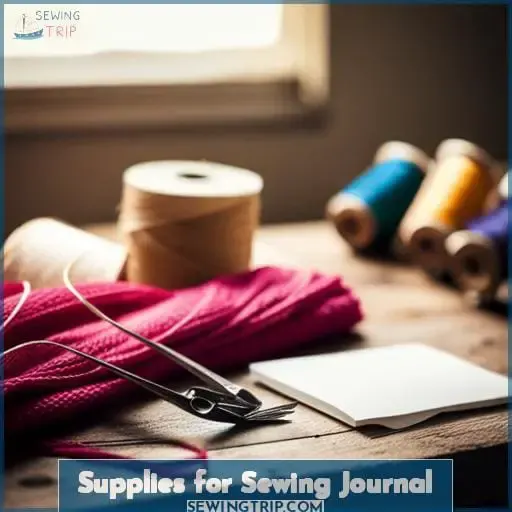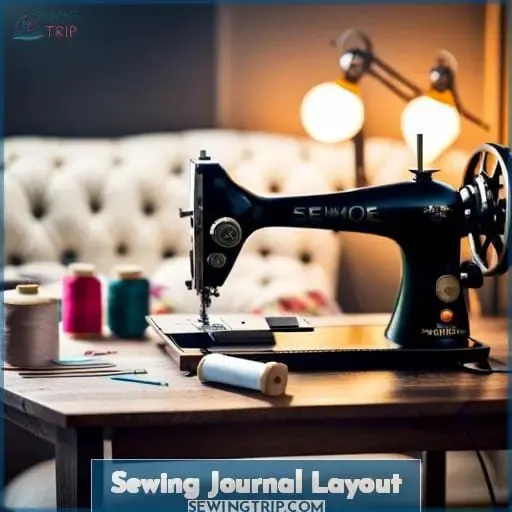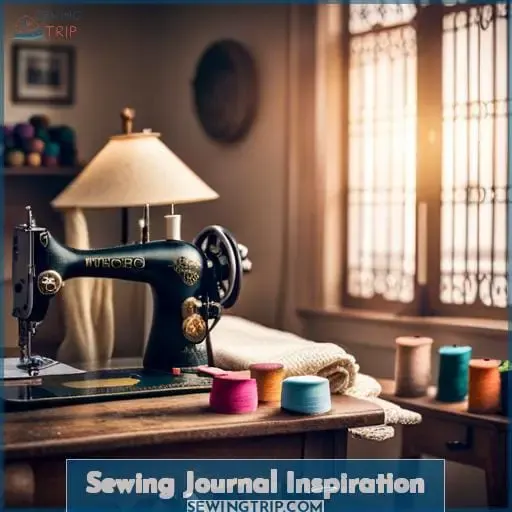This site is supported by our readers. We may earn a commission, at no cost to you, if you purchase through links.
 Roll up your sleeves, sewists!
Roll up your sleeves, sewists!
Let’s dive into your sewing journey and document every stitch.
Grab your journal to log patterns, sketches, and fabric swatches – a patchwork of memories.
Like following a pattern’s markings, journaling leads to mastery.
By recording each step, you gain power over the process.
Now take the reins and ride into new creative territories, sewing journal by your side.
Table Of Contents
Key Takeaways
- Document project details like pattern info, fabric swatches, measurements, design changes to recreate makes.
- Sketch croquis illustrations of finished garments to visualize end results.
- Capture process photos for outfit close-ups and flat lays.
- Reflect on growth by noting skills learned, adjustments made, feelings about finished pieces.
Why Keep a Sewing Journal?
Keeping a sewing journal has many benefits for sewists looking to track progress, recall details, build skills, and stay motivated.
A journal provides a centralized place to document each project from start to finish.
Looking back on detailed accounts of materials, techniques, and modifications equips you to recreate projects and apply lessons learned.
Reflecting on the evolution of your skills through journaled projects is incredibly empowering.
Beyond project details, journals allow creative avenues to express your sewing journey through sketches, swatches, and candid thoughts.
When shared online or with friends, journals build community and inspire others.
Let your journal be a masterpiece charting your sewing path.
Record profound lessons, acknowledge milestones, and pen motivational messages to future self on its pages.
Let your journal nurture progress and self-discovery.
Supplies for Sewing Journal
Grab a blank journal or notebook to document your makes in.
Make sure it has enough pages for all your projects!
You’ll also want pens, markers, or colored pencils for sketching out your garments and adding pops of color to your journal pages.
Journal
The first journal you’ll need for your sewing journal is a blank notebook or journal to serve as the foundation for documenting your sewing projects and journey.
- Choose a hard or soft cover notebook based on personal preference. Hardcover journals tend to lay flat more easily.
- Opt for a journal with unlined, dot grid, or graph pages to allow flexibility in layouts.
- Pick a journal size that has enough space for sketches, photos, fabric swatches, and writing.
- Consider a journal with pre-numbered pages or add page numbers yourself.
- Look for acid-free paper to help preserve fabric scraps and photos glued into the journal.
Pens and Markers
When choosing pens and markers for your sewing journal, select tools that let you color in your outfits and add creative flair to your pages.
Opt for pens and markers that allow you to add:
- Colorful Creativity through personalized lettering
- Marker Magic details
- Colorful Sketching Styles
Use colorful pens for Design Details like stitching, buttons, and embellishments.
Try different pens and markers to find those that fit your style and inspire you to log your makes in a fun, creative way.
Let pens and markers help you put your personalized stamp on your sewing journal pages through doodles, drawings, and coloring.
With the right pens and markers, you can make your sewing journal as unique as your creative sewing talents.
Sewing Journal Layout
When designing your sewing journal pages, start by noting the month and project name in the top corner.
Log key details like the start and end dates, difficulty level, and any pattern adjustments on the left side.
Include a fabric swatch, pattern info, and a croquis sketch to visually capture each make.
Monthly Make
Each month, you’ll note the month’s make at the top left corner of each journal page.
Purposefully planning for the monthly make empowers you to craft for Creative Croquis, Promo Perfection, Pattern Play, Swatch Stories, and Sketch Success in your sewing journal’s monthly planning pages while garment sewing.
Noting each make helps with project details and wardrobe planning.
Promo Box
To showcase your sewing projects in a visually appealing way, include a promo box on each page of your sewing journal.
Use custom stamps, washi tape, glitter pens, or magazine clippings for creative promo ideas that add a personal touch and visual appeal to your journal pages.
Fabric Swatch
After deciding on the overall layout, glue a scrap of the fabric you used for each make to a designated area of the page.
Add textile to recall material memories.
Inspire future explorations in texture.
Allow for pattern pairing and color harmony.
Pattern Information
Under the fabric swatch, jot down both the pattern name and view, along with the size you used for that particular make.
Creative Croquis chart Pattern Chronicles and Fabric Stories, detailing Personal Reflections through Journaling Tips.
On the date started, design, and log your makes.
Croquis Sketch Box
Next, you’ll need a croquis sketch box at the bottom right corner of each page, 20 dots long by 12 dots wide, to draw your own custom model wearing your makes.
Use a custom croquis stamp for creative rendering and to personalize your journal.
Experiment with croquis techniques like custom sizes from companies like My Body Model.
Documenting Your Makes
Keeping track of the details for each project you complete is an important part of journaling.
Be sure to include information like:
- Pattern name and number
- Fabric details
- Key measurements
- Any design changes or personalizations
Sketching a quick croquis of the finished garment is also a great way to document your makes.
Information to Include
You should include essential details like the pattern name and number, fabric type, construction notes, and modifications for each make that you document in your sewing journal.
Capture the garment’s story through photos showing the full outfit on you or the recipient, detailed close-ups of special design elements, and flat lays displaying stitching and seam finishes.
Note pattern adjustments, difficult steps, skills learned, feelings about the finished piece, and anything else worth remembering for next time.
Whether handwritten or digital, your journal allows reflection on growth in skills and style when you log comprehensively.
Celebrate your sewing journey by journaling thoughtfully.
Croquis Sketches
With croquis sketches, you’re illustrating the finished garment on a figure template.
Custom croquis allow you to sketch garments to scale on a body that matches your measurements.
Get creative with croquis placement and layouts in your journal, like grouping croquis together to display a coordinated outfit.
While hand-drawing croquis takes practice, digital alternatives exist too.
Despite challenges, embrace customizing croquis as a way to make your journal uniquely you.
Log key details like garment name and fabric.
Croquis become visual references to retrospect on makes.
Through journaling, we gain clarity and feel empowered to continue our creative sewing journey.
Sewing Journal Inspiration
Some of you can look online for roundups of sewing journal posts that showcase the creative ways people document their makes as extra sources of inspiration.
Share your journaling process and finished journals on social media to connect with the sewing community.
Seeing how others track their sewing progress can spark new ideas for your own journal layout and content.
Consider creating a digital journal using sewing apps or online platforms if that suits your lifestyle better.
Play around with different journaling techniques to find what inspires you most – maybe colorful pages, decorative touches, written reflections.
Establish a monthly review ritual to revisit your journal.
Celebrate learnings, identify patterns in your makes, set intentions.
Let your journal nourish self-compassion.
Sewing journals aren’t meant to shame; they encourage mindful creating.
Use them to focus your sewing goals, not confine your creativity.
Bake inspiration into your journal’s recipe.
Additional Sewing Journal Ideas
Expand your sewing journal by adding sections for:
- Machine Settings
- Notions Used
- Project Cost Tracking
- Design Sketches
- Body Measurements
- Monthly Planning Pages
- Wardrobe Planning
Consider going digital with apps or online platforms for your sewing journal. Share pages on social media to connect with the sewing community. Explore different journaling techniques and themes like seasonal capsule wardrobes.
Challenge yourself by logging tricky projects requiring new skills like jeans, swimsuits, or tailored jackets. Use your journal to reflect on progress and set future goals. Add a hemband pattern to standard patterns for a clean finish.
With some creativity, you can customize your journal into a valuable sewing resource.
Frequently Asked Questions (FAQs)
How often should I update my sewing journal?
Update your sewing journal regularly, ideally after finishing each project.
This ensures details stay fresh and accurate.
Aim to journal at least weekly if you sew frequently, or after every project if sewing sporadically.
Consistency is key for maintaining a thorough, helpful record of your sewing journey.
Can I include drawings or photos in my sewing journal?
Yes, you can absolutely include drawings or photos in your sewing journal.
This visual documentation will help you recall important details and track your progress over time.
Sketch your design ideas, paste in fabric swatches, or add snapshots of the finished garment.
Images tell rich stories to supplement your written notes.
What is the best way to organize my sewing journal?
- Include organized sections for project details, fabric swatches, and photos to keep thorough records.
- Dedicate pages for each make’s pattern info, adjustments, costs, and learnings to reflect on progress over time.
- Thoughtfully designating spaces for consistent tracking will maximize your journal’s usefulness as a sewing reference.
Should I keep separate journals for different types of projects?
Keeping separate journals for different types of projects can help you stay organized and focused.
A quilting journal, a garment sewing journal, and a general project journal are great options to track your progress in each area of interest.
How do I stay motivated to keep using my sewing journal?
Stay motivated by reviewing past projects.
Feel proud of your progress.
Let the tangible record of your growth inspire your next creation.
Conclusion
Foresooth, to become a master stitcher, your journal shall be thy faithful companion!
With each pattern and fabric logged, ’tis a scrapbook of creations and a wellspring of inspiration.
As thy skills grow, return and trace thy sewing story – what joys and trials have shaped thee?
Then don thy threads anew and ride boldly unto fresh creative pastures, journal in hand to chronicle more textile tales spun.












